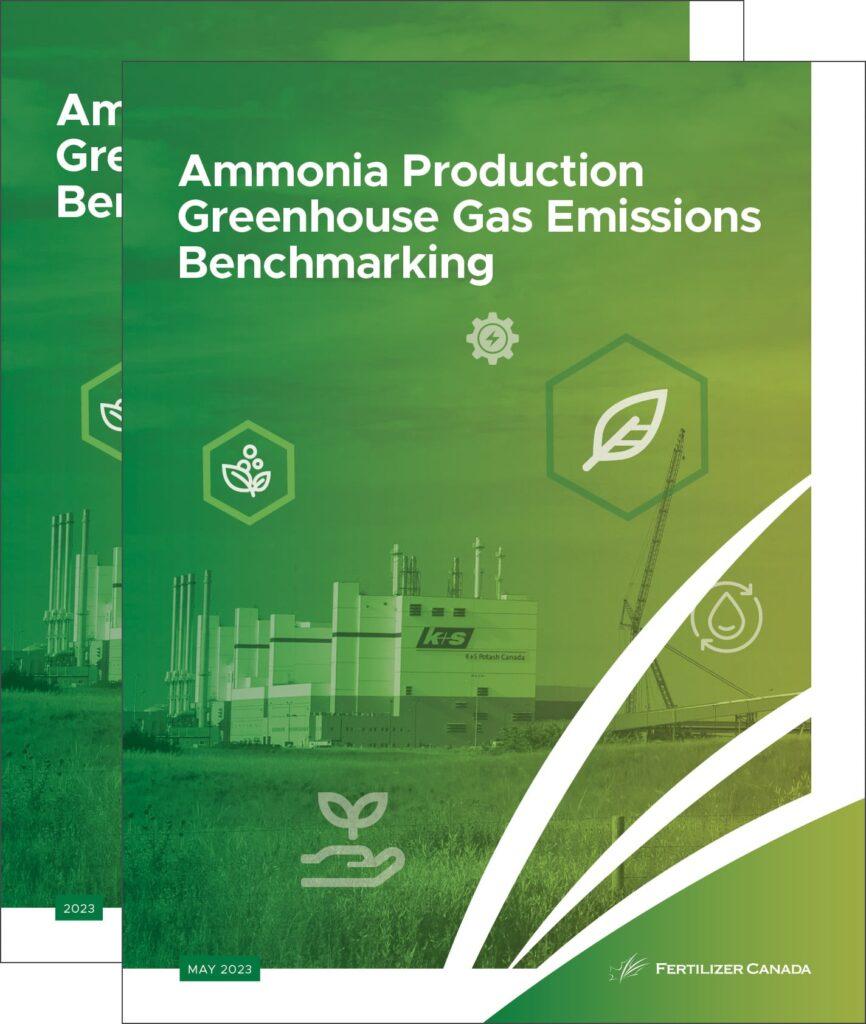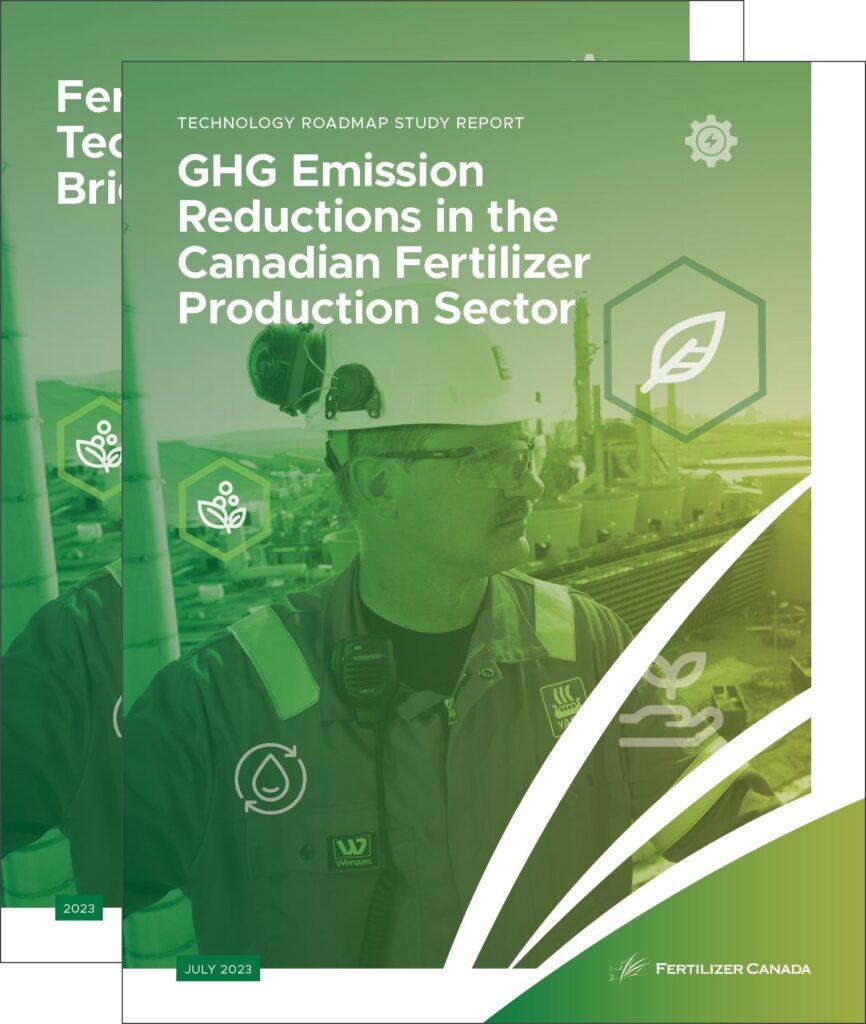
Working Towards Decarbonizing Canada’s Fertilizer Production
Read our latest reports on decarbonizing Canada’s fertilizer production

Download the Ammonia Benchmarking Report & Brief

Download the Tech Roadmap Report & Brief
Read Our Recommendations for Government
Canadian Ammonia Manufacturing
Canada’s ammonia is produced with at least 30 per cent lower net GHG emissions intensity compared to global competitors. Canada’s ammonia is 31 per cent lower than Russia, and 52-63 per cent lower than China, with the range depending on whether the fuel source is coal or natural gas.
Process emissions represent 64 per cent of total generated emissions across the sector, which are fixed by the chemical process and cannot be reduced. Of the total process emissions, 61 per cent are recovered for use in the production of urea, for resale to specialty gas distributors, and/ or carbon capture and storage. Canada’s nine facilities produce 4.9 million tonnes of ammonia annually.
These facilities range from 30 to 67 years old, with most located in Alberta and one each in Saskatchewan, Manitoba, and Ontario.
Nitrogen-Based Fertilizer Production
Canadian Potash Production
Canadian potash is produced with approximately 50 per cent lower GHG intensity than other parts of the world. In comparison to our competitors we produce potash with 1.86 times less CO2 emissions than Russia and Central Europe and 2.5 times less CO2 emissions than China and India.
Potash is a mined mineral used for potassium (K) fertilizer. In Canada there are two ways to mine it, through a conventional mine or a solution mine. In a conventional mine potash is extracted from underground deposits through conventional mining equipment and brought to the surface for additional processing. In a solution mine a brine solution is heated and injected into the deposit. The brine dissolves the potash, and the solution is returned to the surface for further processing.
Solution mining is energy-intensive, and the extraction process represents 24 per cent of potash production emissions. Extraction of potash through traditional mining represents 15 per cent of potash production emissions.
Canada produces 31 per cent of the world’s potash and exports 90-95 per cent. Potash is second only to gold in export value in Canada.
Potash fertilizer production – conventional mine
Potash fertilizer production – solution mine
Map of facilities across Canada
Technology
Status and next Steps
Carbon Capture Utilization and Storage
Emission Reduction Potential
High (>50 per cent reduction in production emissions)
Timeline
5-10 years
Cost
High Capital Costs (>$50 million) / Medium Operating Costs (increase above status quo)
Technology Applicable To
Nitrogen and Potash
Technology Readiness
Commercially available
Carbon Capture Utilization and Storage (CCUS) involves the process of capturing CO2 emissions and either storing it, usually underground, or using it to make new products. In fertilizer production there are two sources of CO2: process emissions from reactions in the nitrogen fertilizer manufacturing process and combustion emissions from the combustion of fuel for energy. In ammonia production, process emissions are captured and utilized downstream as a feedstock to produce urea with 61 per cent of nitrogen fertilizer process emissions already repurposed for use in urea fertilizer production, and therefore are not available for CCUS. High costs and the need for infrastructure pose barriers.
Hydrogen Production through Electrolysis
Emission Reduction Potential
Medium to High (10-50+ per cent reduction in production emissions)
Timeline
5-10+ years
Cost
High Capital Costs (>$50 million) / High Operating Costs (significant increase over status quo)
Technology Applicable To
Nitrogen
Technology Readiness
Feasibility
Electrolysis is the process of splitting water into oxygen and hydrogen, using electricity and water to generate hydrogen, rather than natural gas. This can replace steam methane reforming of a natural gas feedstock for the production of ammonia. The technology is dependent on the carbon intensity of the electricity grid, requiring a reliable electricity supply at a low intensity and low price, as well as access to water. It is only available on a small scale and has high capital and operating costs.
Small Modular Reactors
Emission Reduction Potential
Medium (10-50 per cent reduction in production emissions)
Timeline
5-10 years
Cost
High Capital Costs (>$50 million) / Low to Medium Operating Costs (similar to status quo to increase above status quo)
Technology Applicable To
Nitrogen and Potash
Technology Readiness
Demonstration projects
Small Modular Reactors (SMR) are nuclear fission reactors that are smaller than traditional nuclear power plants and offer potential benefits for sites that are located off-grid or in regions that are supplied by high carbon intensity electricity. GHG reduction potential will depend on the emissions intensity of the power grid in the province. There are concerns among the public about safety aspects and the regulatory licensing process federally and provincially. The technology is at the demonstration project phase and not commercially available.
Congeneration
Emission Reduction Potential
Low to Medium (up to 50 per cent reduction in production emissions)
Timeline
1-5 years
Cost
Medium to High Capital Costs (>$50 million) / Low to Medium Operating Costs (similar to status quo to increase above status quo)
Technology Applicable To
Nitrogen and Potash
Technology Readiness
Commercially available
Cogeneration is the process of generating electricity and useful heat simultaneously using one process. This is considered a transitional technology that needs to be paired with CCUS of combustion emissions in the long term to maximize carbon reductions. Regulatory barriers exist in some provinces concerning who can buy or sell power, such as in Saskatchewan.
Electrification of Mine Fleets Converts Diesel
Emission Reduction Potential
Low (>10 per cent reduction in production emissions)
Timeline
5-10 years
Cost
Low Capital Costs / Low to Medium Operating Costs
Technology Applicable To
Potash (conventional mines)
Technology Readiness
Early stage of commercially available
Electrification of mine fleets converts diesel vehicles and machinery used in potash mining to an electric battery-powered fleet. Timelines depend on availability of electric options for equipment. GHG reduction potential is low because mine fleet emissions are a relatively small portion of overall sector emissions. The reduction potential is dependent on the carbon intensity of the electricity grid replacing diesel.
How We Work with Government to Strengthen the Fertilizer Production Sector While Helping Reach Canada’s Emissions Reduction Goals
Energy efficiency measures to reduce GHG emissions have already been implemented, such as de-bottlenecking and minimizing the amount of natural gas used as a fuel, which is reflected in the carbon intensity of the Canadian sector being one of the lowest globally. Emerging technologies that will result in a significant reduction in sector GHG emissions will take at least five to ten years to implement and could cost upwards of $1 billion per facility based on similar public projects.
Government climate goals are ambitious, and the fertilizer production and manufacturing sector needs government support at all levels that is equally as ambitious. Timelines for availability and incentives must align with net zero ambitions. The Canadian fertilizer industry has the knowledge and expertise to assist governments in meeting their climate objectives.
Government Recommendations:
- Provide federal and provincial regulatory certainty and long-term commitments that promote investments in decarbonization technology, along with targeted programs and investment tax credits that reflect the timelines and cost for these technologies. As well as look to other jurisdictions when developing policies and funding mechanisms to emulate their success, ensure Canada is competitive, and protect domestic fertilizer production.
- All levels of government work in collaboration with industry to ensure policies reflect realistic timelines for the wide commercial adoption of decarbonization technologies and adjust funding programs to support technology at early stages of development such as feasibility and engineering level studies. As well as clarify and simplify regulatory approvals for decarbonization technologies to expedite technology readiness.
- Work with industry and stakeholders to build out infrastructure our industry depends on beyond our fence-line to make significant reductions in GHG emissions, such as CO2 pipelines and a reliable, affordable, clean electricity grid.

